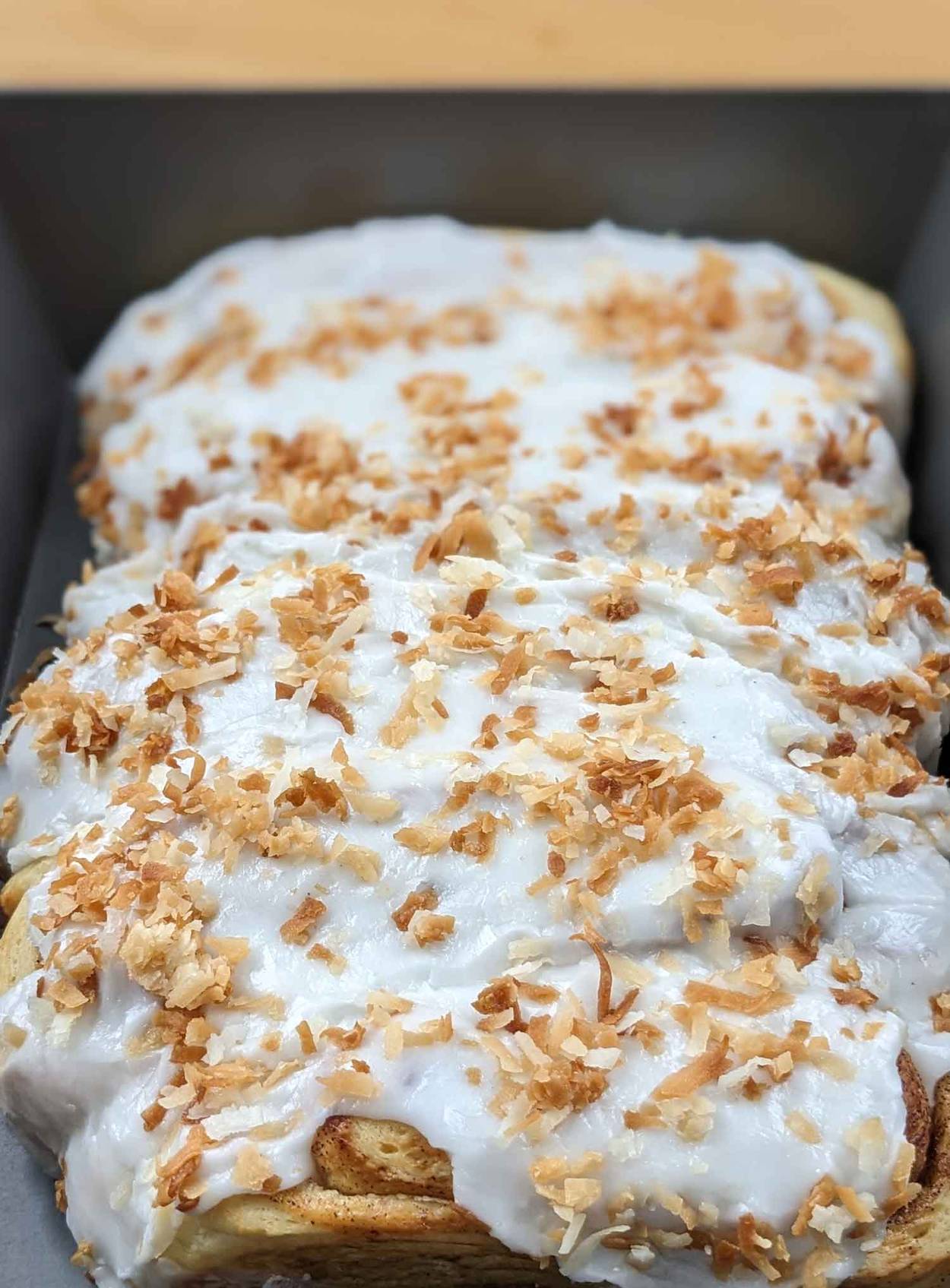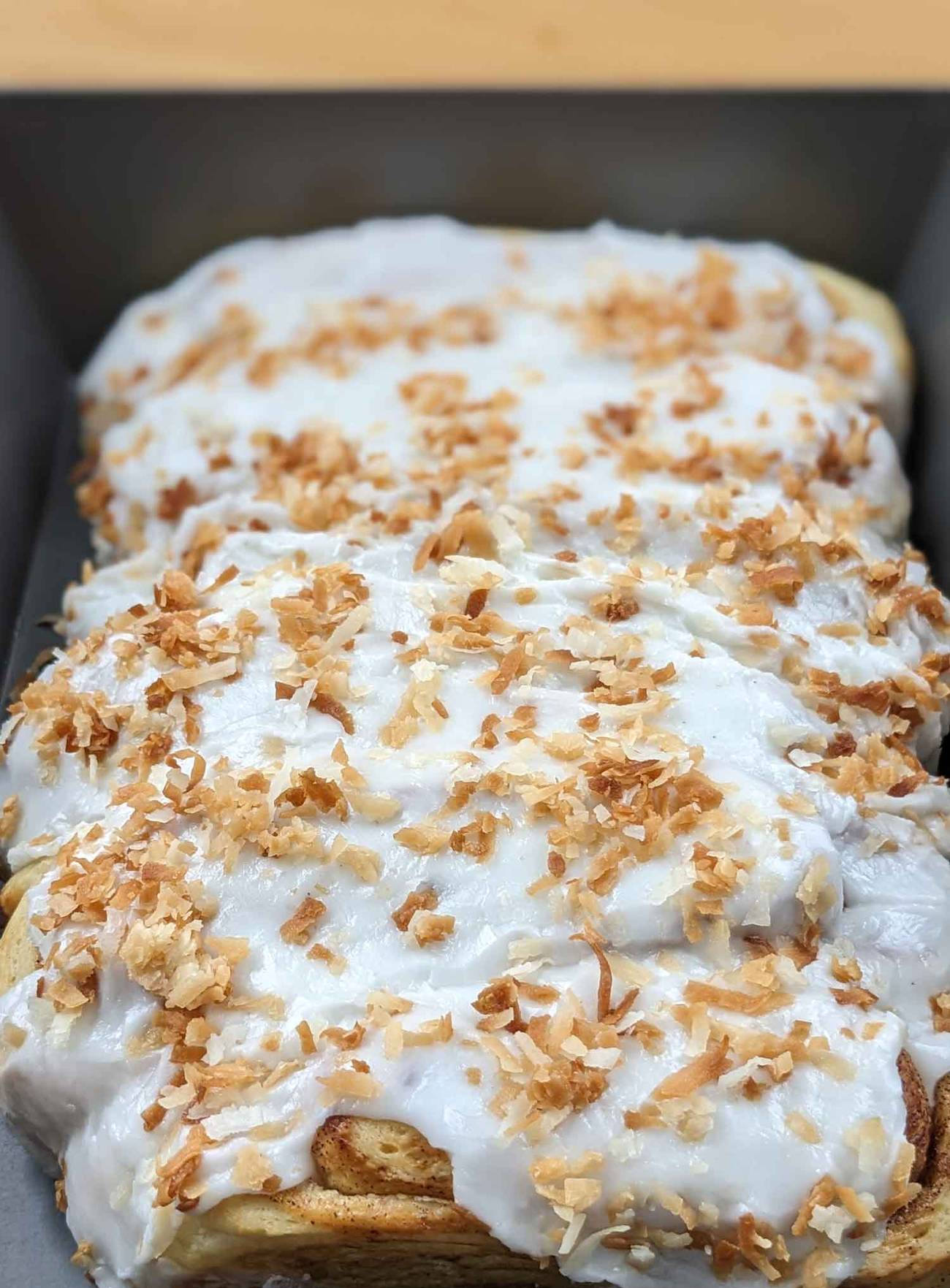The Sweet Taste of Childhood—With Coconut on Top
Reconstructing a recipe for the rolls my grandfather remembers from his early days in Milwaukee

Courtesy the author

Courtesy the author

Courtesy the author

Courtesy the author
Just after sunrise on a Sunday morning in 1943, a 13-year-old could go into the Salinsky family bakery on the then-Jewish west side of Milwaukee, and for a mere 30 cents could walk out with six coconut sweet rolls.
I know this because the 13-year-old in question is my grandfather Fred Wiviott, who still remembers his weekly ritual after finishing his paper route: “I’d walk past this bakery, and I’d smell them, and I couldn’t resist it,” he told me. Having just delivered the hefty Sunday edition to his 70 customers—a job that brought him a weekly salary of $5—he’d wind up eating all six sweet rolls on his way home. “We used to call them schnecks,” he said.
A stranger might look at the various aspects of my grandfather’s life and mistake him for an unsentimental man—a Korean War veteran, half lawyer and half engineer, a weekend golfer, a fanatic of 1950s war films, a carpenter. A Midwesterner in a gray flannel suit. But on noticing his sweet tooth, one will suddenly glimpse a boyish warmth, an unfaltering giddiness, a love of bodily pleasures and the natural world expertly played off as everyday indulgences, a memory so lush and full and molded by the kind of things that I, in my 30s, am only just now beginning to understand. The engineer in him can look back 80 years and recall the exact dimensions of those coconut sweet rolls: each one a yeasted pastry roughly 2 inches wide, and 4 inches long, with cinnamon sugar between each layer, and slathered in a layer of white vanilla frosting and shredded coconut. The rolls came stuck together; one by one, he’d tear into them on his way home.
My grandfather, like most Jews in Milwaukee, left the old neighborhood before the 1960s. The Salinskys closed their bakery. The baker pivoted to selling real estate. Now and then, at one of the few remaining Jewish establishments, a similar schneck could be found. But slowly, those, too, disappeared entirely. “Don’t think he doesn’t ask all the time,” my grandmother Esther said to me. “But nobody ever has them.”
This Sunday ritual easily explains my grandfather’s lifelong love of coffee cake—in particular, Entenmann’s cinnamon swirl buns, which from his description of schnecks, seem like a distant cousin of the thing he knew from his childhood. The problem with cinnamon swirls, however, is that the dough itself is too sweet, whereas the coconut sweet rolls were made of a barely sweetened dough, allowing the flavors of coconut and cinnamon to stand out. And none of these other rolls ever seems to come with coconut on top.
In the course of my many and ultimately failed attempts to divine some recipe for these coconut sweet rolls as a surprise for my grandfather, I trawled the internet, badgered the owners of Jewish bakeries for hints, and even had my grandmother see if she could track down a recipe from the original family. But I’d never imagined that a version of this elusive recipe was in my grandparents’ house all along.
The story of schnecks goes back far beyond those Sunday mornings in 1943. The word itself likely comes from the German word for snail, Schnecke, because of the way the dough is coiled. And one of the only places where you can find a codified recipe for schnecken is in a cookbook from 1901 that acts as a compendium of recipes from the Jewish immigrants who wound up in Milwaukee almost 150 years ago: The Settlement Cook Book.

Courtesy the author
The story of the schnecks coils around itself even further than that. The Milwaukee Jewish Mission, founded in 1896 by Lizzie Black Kander and later known simply as “The Settlement,” was started as a social welfare settlement that provided basic aid to the wave of Jewish immigrants arriving in Milwaukee. As it grew—it would later become the JCC of Milwaukee—The Settlement offered vocational training, health care, bath houses, and cooking classes. These cooking lessons were the foundation of the recipes printed in The Settlement Cook Book. Conveniently, the 1903 edition happened to be available for Kindle on Amazon.
And buried in the 300-page, fine-print, at times incoherently structured tome, is a recipe for what to do with leftover pastry dough: Roll it into schnecken. In another chapter there is a recipe for vanilla frosting—a white icing much like the one my grandfather remembered. Kander’s cookbook, structured in the form of lessons for burgeoning home cooks, became one of the seminal American cookbooks, and even succeeded at introducing Jewish recipes into the American home. The cookbook was revised well over a dozen times, sometimes even in consecutive years, which meant that the recipes changed over time, and can vary wildly between editions. The 1903 recipe for schnecken is drastically different from the 1930s and ’40s recipes. I suspect that these changes were made in an attempt by the book’s authors to remain a relevant piece of American culture as Jews further assimilated and mingled their immigrant identities with modern Midwestern American sensibilities. It worked.
The Settlement Cook Book also happens to be one of just two cookbooks on my grandmother’s bookshelf. Hers was a 1950s edition that had sat unopened for years, but one afternoon we sat on the phone as she leafed through the index until at last she came across a recipe: schnecken. It was, not surprisingly, a completely different recipe from any others I’d looked at.
The sweet rolls my grandfather remembered were very likely a spin on the traditional schnecken. In order to arrive at a facsimile of the recipe from the Salinsky family bakery, I had to break down the various components of each recipe throughout the years and adjust them.
The very oldest recipes for schnecks in the pages of The Settlement Cook Book call for a sugared dough—half a cup for every five cups of flour. However, later iterations seem to leave the sugar out of the dough entirely, and instead use sugar as a dredge for the flattened dough. The biggest difference between the canonical schnecks and those my grandfather remembered was that the Settlement recipe seems to yield a dough that will end up fluffy but still have something of a firm exterior. However, those from 80 years ago were fluffy, even on the surface, which, to my mind, meant adding more fat in the form of butter than the recipe called for (a common trick at bakeries and doughnut shops to make things taste better than they might at home), and also allowing for a long rise.
In order to make the schnecks more oblong, I had to make an initial first fold that was almost 2 inches long, rather than rolling the dough into a tightly coiled circle. Before me was a long, flat log, which I sliced into 1 1/4-inch segments and then packed into a baking tray to rise again before going into the oven. Before long, the vaporous smell of cinnamon flitted across my apartment.
I ruined the first batch almost immediately. In my excitement, I slathered room temperature frosting onto the rolls as soon as they came out of the oven, which caused the frosting to separate and run down into the bottom of my pan into a translucent mess that no amount of toasted coconut shavings could hide.
Ahead of the next batch, I put the icing in the freezer, and applied the hard, cold glaze directly to the warm rolls. This time, the frosting glided effortlessly over the rippling hot layers of cinnamon-covered dough, leaving behind a trail of pristine, sugary stalagmites. I sprinkled on the toasted coconut, and sent a photo to my grandparents (my 90-year-old grandmother learned how to text last year).
Unable to resist, I tore one of the fully dressed rolls from its mates. It was not Sunday morning, but rather a Tuesday afternoon, nor was I in Milwaukee, nor was it 1943, but for a moment I tried to imagine myself there, half a century before I was even a germ of an idea, standing on the streets of an old neighborhood I’d hardly ever visited, when all that mattered was quelling the hungry, bleary fatigue of early morning. Is this what he felt all those years ago? Was this symphony of heat and sugar the same as the one he knew so well—the one that drew him back to that bakery week after week?
I ordered packets of dry ice and insulated shipping containers. Thirty-six hours later they arrived on my doorstep. How strange it is that the modern convenience of two-day shipping aided in my attempt to transport someone to a time when commercial air travel was still something of a novelty.
I do not think that the original architects of this recipe would have imagined that a thing sold for five cents could have left such an impression on a young boy that his grandchildren would hear about them almost a century later. Or maybe it is the nature of these deceptively simple things that they are, by design, intended to surprise us, that they leave an imprint where we least expect, and remain a lone fossil, a tether to the nearly forgotten and to the should-have-been-forgotten, and that when there is no more bakery, no more paper route, no more Jewish west side even, what remains is only the elusive sweet vapor of an early Sunday morning.
Alexander Aciman is a writer living in New York. His work has appeared in, among other publications, The New York Times, Vox, The Wall Street Journal, and The New Republic.